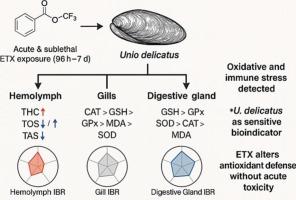Integrated biomarker response-based investigation of oxidative stress in Hemolymph, gills, and digestive glands of freshwater mussels (Unio delicatus) exposed to Etoxazole
IF 4
1区 农林科学
Q2 BIOCHEMISTRY & MOLECULAR BIOLOGY
引用次数: 0
Abstract
Pesticides extensively used in agriculture pose risks to non-target aquatic organisms. This study assessed the acute and sublethal effects of etoxazole (ETX), an isoxazoline-derived acaricide, on the freshwater mussel Unio delicatus. The 96 h LC₅₀ was calculated as 463.97 mg/L (316.29–662.47 mg/L, 95 % CI). Mussels were exposed to sublethal ETX concentrations for 96 h and 7 days. Total hemocyte counts (THCs), total antioxidant status (TAS), and total oxidant status (TOS) were measured in hemolymph. In this study, elevated total hemocyte counts (THCs) indicated activation of cellular immune responses, while reduced TAS together with increased TOS reflected systemic oxidative stress, particularly at higher ETX concentrations. Oxidative stress biomarkers (GSH, GPx, SOD, CAT, MDA) were analyzed in gill and digestive gland tissues. A progressive TAS decline was observed in hemolymph over 7 days. Biomarker responses were evaluated using Min-Max normalization and the Integrated Biomarker Response (IBR) index. IBR profiles revealed tissue-specific stress patterns: in hemolymph, THCs > TOS > TAS suggested pronounced immune activation. In gills, CAT > GSH > GPx > MDA > SOD indicated oxidative defense, while in digestive glands, GSH > GPx > SOD > CAT > MDA reflected detoxification. Although ETX showed low acute toxicity, it significantly altered immune and antioxidant systems. These results demonstrate the sensitivity of U. delicatus to sublethal pesticide exposure and support its use as a sentinel species in ecotoxicological studies.

暴露于乙toxazole的淡水贻贝(Unio delicatus)血淋巴、鳃和消化腺氧化应激的综合生物标志物应答研究
农业中广泛使用的农药对非目标水生生物构成风险。本研究评估了异恶唑衍生的杀螨剂乙toxazole (ETX)对淡水贻贝Unio delicatus的急性和亚致死效应。96小时LC₅0计算为463.97 mg/L (316.29-662.47 mg/L, 95% CI)。贻贝分别暴露于亚致死浓度的ETX中96 h和7 d。测定血淋巴中总血细胞计数(THCs)、总抗氧化状态(TAS)和总氧化状态(TOS)。在这项研究中,总血细胞计数(THCs)升高表明细胞免疫反应激活,而TAS降低和TOS升高反映了系统性氧化应激,特别是在较高的ETX浓度下。分析鳃和消化腺组织氧化应激生物标志物(GSH、GPx、SOD、CAT、MDA)。在7天内观察到血淋巴TAS进行性下降。采用Min-Max归一化和综合生物标志物反应(IBR)指数评估生物标志物反应。IBR谱显示了组织特异性应激模式:在血淋巴中,THCs > TOS >; TAS提示明显的免疫激活。在鳃中,CAT > GSH > GPx > MDA >; SOD表示氧化防御,而在消化腺中,GSH > GPx > SOD > CAT >; MDA表示解毒。虽然ETX表现出低急性毒性,但它显著改变了免疫和抗氧化系统。这些结果证明了细叶蝉对亚致死农药的敏感性,并支持其作为生态毒理学研究的哨兵物种。
本文章由计算机程序翻译,如有差异,请以英文原文为准。
求助全文
约1分钟内获得全文
求助全文
来源期刊
CiteScore
7.00
自引率
8.50%
发文量
238
审稿时长
4.2 months
期刊介绍:
Pesticide Biochemistry and Physiology publishes original scientific articles pertaining to the mode of action of plant protection agents such as insecticides, fungicides, herbicides, and similar compounds, including nonlethal pest control agents, biosynthesis of pheromones, hormones, and plant resistance agents. Manuscripts may include a biochemical, physiological, or molecular study for an understanding of comparative toxicology or selective toxicity of both target and nontarget organisms. Particular interest will be given to studies on the molecular biology of pest control, toxicology, and pesticide resistance.
Research Areas Emphasized Include the Biochemistry and Physiology of:
• Comparative toxicity
• Mode of action
• Pathophysiology
• Plant growth regulators
• Resistance
• Other effects of pesticides on both parasites and hosts.

 求助内容:
求助内容: 应助结果提醒方式:
应助结果提醒方式:


